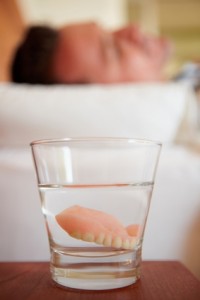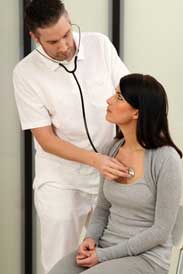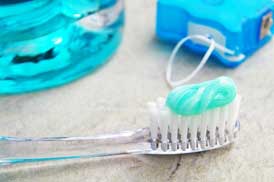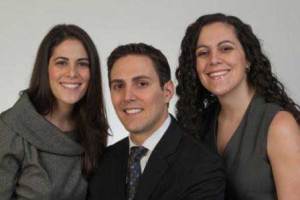Over the last few years there has been an increase or reported cases of MRSA infections. Many of my patients ask me about the risk of oral MRSA infections and how it can effect them. Our mouths are home to over 300 different types of bacteria.  In a healthy mouth, these bacteria work together to create a healthy oral environment. But, as in any other system, if things go awry and the balance becomes upset then we find different types of bacteria take advantage of this and begin to thrive.
In a healthy mouth, these bacteria work together to create a healthy oral environment. But, as in any other system, if things go awry and the balance becomes upset then we find different types of bacteria take advantage of this and begin to thrive.
Posts
 Okay, I understand getting to the dentist when you have an emergency can sometimes be hard. And, yes I realize that it’s awfully tempting to try and fix the problem yourself. But, there are just some things you should not do at home. This brings us to this weeks blog post. The WORST home remedies for dental problems.
Putting garlic against a sore tooth…. Besides making you smell bad, garlic is very potent and can irritate or burn soft tissues around the tooth causing even more pain and sensitivity.
Shaving down a sharp tooth with tools from around the house… Besides the fact that you are putting something that has seen more dirty surfaces than I’d care to mention directly into your mouth, you are putting yourself at risk for damaging the tooth more or slipping and causing damage to your cheeks and gums.
Using crazy glue to fix a broken natural tooth... Yes, I know people say the same stuff that’s in super glue is the same stuff used to seal battlefield wounds, and they’d be correct. However, the stuff used to seal battlefield wounds are made specifically to seal battlefield wounds. Using superglue to fix a tooth most likely will result in 1: You super gluing your finger to your lip, cheek, tooth or some variation of the aforementioned. Or 2: Pain from a tooth with a freshly injured dental nerve being assaulted by a brand of material that was not meant to see the inside of your mouth or to fix broken teeth. Trust me, its not pretty….
Whitening your teeth with lemon juice and baking soda… This one, although its gotten a lot of popularity throughout the years, is just not healthy for your teeth. Mixing an abrasive and an acid together and then scrubbing it on your teeth can cause abrasion to your gums while also removing and/or damaging the enamel on your teeth.
And lastly, searching through your medicine cabinet and finding a left over prescription from those wisdom teeth you (or someone you know) had extracted about ten years ago… Its not a mystery that taking old, expired or another persons prescription medications is a bad idea. Taking one or two remaining capsules of an antibiotic is not only ineffective, it can also help promote bacterial resistance to antibiotics. Also, taking prescription medications that were not prescribed to you can put you right in the middle of an adverse or even allergic reaction to a drug that no one knows you are taking. So if you are having a problem call your dentist or doctor first before resorting to whats left over in the medicine cabinet. Also, whenever you are prescribed medication once you have finished the prescription if there are any tablets remaining they should be disposed of.
So, I’m not saying there are not some things that you can do at home in a pinch to get you by until you can see your dentist. But, in an emergency situation, first and foremost, call your dentist and see when they can see you for an appointment and tell them your emergency. Your dentist will suggest the best way to get you comfortable and safely treated!]]>
Okay, I understand getting to the dentist when you have an emergency can sometimes be hard. And, yes I realize that it’s awfully tempting to try and fix the problem yourself. But, there are just some things you should not do at home. This brings us to this weeks blog post. The WORST home remedies for dental problems.
Putting garlic against a sore tooth…. Besides making you smell bad, garlic is very potent and can irritate or burn soft tissues around the tooth causing even more pain and sensitivity.
Shaving down a sharp tooth with tools from around the house… Besides the fact that you are putting something that has seen more dirty surfaces than I’d care to mention directly into your mouth, you are putting yourself at risk for damaging the tooth more or slipping and causing damage to your cheeks and gums.
Using crazy glue to fix a broken natural tooth... Yes, I know people say the same stuff that’s in super glue is the same stuff used to seal battlefield wounds, and they’d be correct. However, the stuff used to seal battlefield wounds are made specifically to seal battlefield wounds. Using superglue to fix a tooth most likely will result in 1: You super gluing your finger to your lip, cheek, tooth or some variation of the aforementioned. Or 2: Pain from a tooth with a freshly injured dental nerve being assaulted by a brand of material that was not meant to see the inside of your mouth or to fix broken teeth. Trust me, its not pretty….
Whitening your teeth with lemon juice and baking soda… This one, although its gotten a lot of popularity throughout the years, is just not healthy for your teeth. Mixing an abrasive and an acid together and then scrubbing it on your teeth can cause abrasion to your gums while also removing and/or damaging the enamel on your teeth.
And lastly, searching through your medicine cabinet and finding a left over prescription from those wisdom teeth you (or someone you know) had extracted about ten years ago… Its not a mystery that taking old, expired or another persons prescription medications is a bad idea. Taking one or two remaining capsules of an antibiotic is not only ineffective, it can also help promote bacterial resistance to antibiotics. Also, taking prescription medications that were not prescribed to you can put you right in the middle of an adverse or even allergic reaction to a drug that no one knows you are taking. So if you are having a problem call your dentist or doctor first before resorting to whats left over in the medicine cabinet. Also, whenever you are prescribed medication once you have finished the prescription if there are any tablets remaining they should be disposed of.
So, I’m not saying there are not some things that you can do at home in a pinch to get you by until you can see your dentist. But, in an emergency situation, first and foremost, call your dentist and see when they can see you for an appointment and tell them your emergency. Your dentist will suggest the best way to get you comfortable and safely treated!]]>
 effort to keep our patients informed on the most recent dental information we assembled the facts about this study and its findings and our views on dental x-rays.
The study suggests that dental x-rays, particularly when obtained frequently and at a young age, may be associated with an increased risk of an intracranial meningioma. The study compared dental and therapeutic radiation histories in 1433 patients against a control group of 1350 subjects. The study was conducted via telephone interviews with patients and information accrued via patients memory. Due to dental records being held at various offices, researchers were unable to validate the samples history due to time and financial considerations.
effort to keep our patients informed on the most recent dental information we assembled the facts about this study and its findings and our views on dental x-rays.
The study suggests that dental x-rays, particularly when obtained frequently and at a young age, may be associated with an increased risk of an intracranial meningioma. The study compared dental and therapeutic radiation histories in 1433 patients against a control group of 1350 subjects. The study was conducted via telephone interviews with patients and information accrued via patients memory. Due to dental records being held at various offices, researchers were unable to validate the samples history due to time and financial considerations.
- The study states that: “No studies have reported on the association between use of computed tomography (CT) and meningioma risk” as well as: ” The studies that report on dental x-ray exposure are suggestive but are limited by sample size and by the inclusion of cases from time periods with higher dosing regimes than the current era”
- Meningioma’s are common benign brain tumors originating in the meninges. As reported by the Cancer Brain Tumor Registry of the United States, “Primary brain tumors represent only 2% of all cancers, with 35,000 new cases diagnosed each year in the United States,” “Meningioma’s occur at a rate of 7.8 per 100,000 per year, but only 25% are believed to be symptomatic, with the others being found incidentally.” Because the overall prognosis for this type of tumor is good and the tumors are commonly asymptomatic, only being found incidentally, many doctors do not recommend treating them and opt to observe the tumors instead.
- Dr. Elizabeth Claus, the lead author of the study reported is quoted as saying: “Our take home message is don’t panic. Don’t stop going to the dentist” and ” Our study refers to exposures in the past rather than exposures that people are receiving in this day and age”
- The American Dental Association’s position on dental x-rays is that dentists should order dental x-rays for patients only when necessary for diagnosis and treatment.
Dental x-rays and risk of meningioma; Elizabeth B. Claus MD, PhD1,2,§,*, Lisa Calvocoressi PhD1, Melissa L. Bondy PhD3, Joellen M. Schildkraut PhD4, Joseph L. Wiemels PhD5, Margaret Wrensch PhD5,6
]]>  Ever look on the back of the toothpaste box and wonder, what exactly is xanthan gum and why the heck is it in my toothpaste? Well wonder no more, as we go through how to decode the toothpaste label…
On every drug facts label you find a listing of active ingredients and inactive ingredients, as well as what its used for, any warnings for the product and directions for uses.
Active Ingredients: This is the part of the toothpaste that makes its use effective. In the case of most toothpastes the active ingredient is usually for anti-plaque, anti-cavity, anti-gingivitis as well as including ingredients to help prevent tooth sensitivity. So in this portion you will normally see your fluorides such as sodium fluoride, stannous fluoride or sodium monofluorophosphate. You may also see potassium nitrate, triclosan, pyrophosphates or zinc salts as well as a myriad of other ingredients.
Inactive Ingredients: This portion includes the ingredients that make the toothpaste standup to being on the shelf as well as completing the nuts and bolts function of general toothpaste use. So these ingredients stop the paste from drying out, keep it at a good pH, stop microbial growth, make them thick enough for use and help them become foamy when used. They also include flavoring agents, abrasives and whitening agents. So in this section, which in my opinion is the most confusing you’ll see these types of ingredients:
Ever look on the back of the toothpaste box and wonder, what exactly is xanthan gum and why the heck is it in my toothpaste? Well wonder no more, as we go through how to decode the toothpaste label…
On every drug facts label you find a listing of active ingredients and inactive ingredients, as well as what its used for, any warnings for the product and directions for uses.
Active Ingredients: This is the part of the toothpaste that makes its use effective. In the case of most toothpastes the active ingredient is usually for anti-plaque, anti-cavity, anti-gingivitis as well as including ingredients to help prevent tooth sensitivity. So in this portion you will normally see your fluorides such as sodium fluoride, stannous fluoride or sodium monofluorophosphate. You may also see potassium nitrate, triclosan, pyrophosphates or zinc salts as well as a myriad of other ingredients.
Inactive Ingredients: This portion includes the ingredients that make the toothpaste standup to being on the shelf as well as completing the nuts and bolts function of general toothpaste use. So these ingredients stop the paste from drying out, keep it at a good pH, stop microbial growth, make them thick enough for use and help them become foamy when used. They also include flavoring agents, abrasives and whitening agents. So in this section, which in my opinion is the most confusing you’ll see these types of ingredients:
- Propylene glycol, glycerol, and polyethylene glycol to help keep toothpaste moist
- Carageenan, cellulose and xanthan gum to thicken and hold all the ingredients together
- Sodium benzoate and methyl paraben to keep toothpaste from decaying and to prevent microbial growth
- Sodium lauryl sulphate and cocoadmidopropyl betaine to make toothpaste foam thereby helping loosening and removing plaque from the tooth surface.
- sodium saccharin, xylitol, sorbitol, sodium cyclamate to flavor the toothpaste.
- Buffering agents to make it a pH favorable for the oral environment.
- And, you may see silicas, dicalcium phosphate dihydrate or aluminum oxide which are abrasives which help remove plaque and bacteria as well.
 Conscious sedation is a procedure that allows you to get the dental care you need while remaining stress free and comfortable.
Conscious sedation is defined as a minimally depressed state of consciousness that allows the retention of the ability to respond and react to physical stimulation and verbal command. During the sedated state most patients experience an amnesic effect that can erase any memory of the procedure.
It is a great tool that can help you achieve the smile you’ve always wanted but were kept from getting due to your fear of the dentist. If you are afraid to go to the dentist, or just anxious about certain aspects of your dental treatment, sedation may be a solution to your anxiety.
Unlike general anesthesia where the patient is unconscious or asleep, conscious sedation allows you to be awake but in a very relaxed state. Our certified IV conscious sedation dentist, Dr. Tina Frangella, can give you the ability to have your dental treatment completed while you are in a sedated and relaxed state.
Sedation Dentistry can give you the peace of mind you need in order to undergo dental work with no memory of the treatment that was done. It will allow you to receive the care necessary for you to enjoy better overall health, an improved self-image, and better quality of life with a healthy, beautiful smile.]]>
Conscious sedation is a procedure that allows you to get the dental care you need while remaining stress free and comfortable.
Conscious sedation is defined as a minimally depressed state of consciousness that allows the retention of the ability to respond and react to physical stimulation and verbal command. During the sedated state most patients experience an amnesic effect that can erase any memory of the procedure.
It is a great tool that can help you achieve the smile you’ve always wanted but were kept from getting due to your fear of the dentist. If you are afraid to go to the dentist, or just anxious about certain aspects of your dental treatment, sedation may be a solution to your anxiety.
Unlike general anesthesia where the patient is unconscious or asleep, conscious sedation allows you to be awake but in a very relaxed state. Our certified IV conscious sedation dentist, Dr. Tina Frangella, can give you the ability to have your dental treatment completed while you are in a sedated and relaxed state.
Sedation Dentistry can give you the peace of mind you need in order to undergo dental work with no memory of the treatment that was done. It will allow you to receive the care necessary for you to enjoy better overall health, an improved self-image, and better quality of life with a healthy, beautiful smile.]]>
 Being a dentist and being surrounded by a lot of dentists, I’ve had the opportunity to try a lot of dental products over the years and learn the opinions of my friends, family and colleagues about these same products.
I decided to compile a list of my absolute favorite, tried and true, dental products on the market. Of course I’m always open to try something new, so if you have any favorites, please let us know!
Being a dentist and being surrounded by a lot of dentists, I’ve had the opportunity to try a lot of dental products over the years and learn the opinions of my friends, family and colleagues about these same products.
I decided to compile a list of my absolute favorite, tried and true, dental products on the market. Of course I’m always open to try something new, so if you have any favorites, please let us know!
Toothbrush: Sonicare
This toothbrush’s sonic motion and handy timer really make a difference in your smile. It’s the best home care tool in my opinion.Floss: Glide
Whenever I buy floss, I tend to lean towards an unwaxed tape variety rather than a rope. Glide is great b/c its easy to manuever between teeth and doesn’t shred easily.Regular Toothpaste: Crest Original (with sodium fluoride)
Crest is a great product. I like the flavor of the paste and usually prefer sodium fluoride in my toothpaste as opposed to stannous fluoride. When I’m looking to buy a regular toothpaste I usually stick to the Crest Original.Toothpaste for Sensitive Teeth: Sensodyne Isoactive
For patients that are long time users of toothpaste for sensitive teeth, this new product is a great change from the dull chalky tasting toothpastes that have been on the market. I tried this product about 6 months ago and use it from time to time when my teeth become hot & cold sensitive. It forms a refreshing foam that leaves you with a great taste and more comfortable teeth as well.Whitening Toothpaste: Crest 3d White
When brushing your teeth in between whitenings to keep that beautiful fresh smile I like to use this Crest 3d White. It’s Crest, which has a great line of whitening products, and also has a great taste and is very effective in maintaining a bright smile.Antibacterial Mouthwash: Listerine and Closys
An antibacterial mouthwash is crucial to home care. The hard part is sorting through all the options and finding whats right for you. My top two picks are: CloSys and Listerine. I love CloSys because although it has a mild flavor, it is a great tool to kill bacteria that can lead to periodontal disease and also it is less acidic than many of the rinses on the market. My other top pick is Listerine. In my opinion Listerine is hands down the most effective antibacterial rinse on the market. My morning routine usually includes a quick rinse with CloSys then a thorough brushing & flossing followed by a rinse with Listerine.Fluoride Mouthwash: ACT Total Care
I always rinse with ACT right before bed. It has a great flavor (my favorite is the green one), probably the best tasting of all the mouthrinses I’ve tried, and is very effective in helping remineralize and strengthen enamel. Another great product worth trying.100% Xylitol Gum: Epic (epicdental.com)
Xylitol is a great sugarfree product that is important to home care. I usually opt for 100% Zylitol chewing gum (right now I’m addicted to Epic cinnamon flavor). The only downfall is the chewing gum doesn’t keep its flavor for that long. But on the upside, even after only chewing it for a short amount of time, my mouth feels really fresh and clean afterwards. And it’s a great way of delivering Xylitol, which is the only sugar substitute that studies have shown that has cavity fighting properties.]]>  1. Celebrity Smile Makeovers
2. The Seven Myths of Teeth Whitening
3. Teeth Whitening: How White Is Too White?
4. Are Teeth Whitening Kiosks at the Mall Safe?
5. No Time for Teeth Whitening? 4 Tricks for Making Teeth Appear Whiter
6. Why Do I Have Tooth Sensitivity After a Filling?
7. Bad Breath…Top Three Causes
8. Can Sugar Free Gum Prevent Cavities?
9. “It’s Halloween! What Do I Do With All This Candy?”
10. The Truth About Porcelain Veneers
Which post did you learn the most from? Have you scheduled your dental appointment for 2012 yet?
Wishing you a healthy and prosperous New Year!
]]>
1. Celebrity Smile Makeovers
2. The Seven Myths of Teeth Whitening
3. Teeth Whitening: How White Is Too White?
4. Are Teeth Whitening Kiosks at the Mall Safe?
5. No Time for Teeth Whitening? 4 Tricks for Making Teeth Appear Whiter
6. Why Do I Have Tooth Sensitivity After a Filling?
7. Bad Breath…Top Three Causes
8. Can Sugar Free Gum Prevent Cavities?
9. “It’s Halloween! What Do I Do With All This Candy?”
10. The Truth About Porcelain Veneers
Which post did you learn the most from? Have you scheduled your dental appointment for 2012 yet?
Wishing you a healthy and prosperous New Year!
]]>
 We want to cover the topics that you really want to know about.
What’s the best way of finding these topics? Going directly to the source- our patients and readers!
Send us a question or topic that you would like us to write about and we’ll address it in one of our upcoming blog posts.
And of course, if you have any personal concerns, call us at our office: (212) 245-2888.]]>
We want to cover the topics that you really want to know about.
What’s the best way of finding these topics? Going directly to the source- our patients and readers!
Send us a question or topic that you would like us to write about and we’ll address it in one of our upcoming blog posts.
And of course, if you have any personal concerns, call us at our office: (212) 245-2888.]]>
